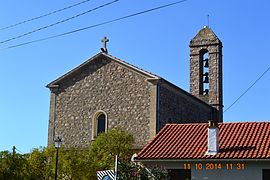Ambiegna
| Ambiegna | |
|---|---|
| Commune | |

The church of Saint-Côme and Saint-Damien, in Ambiegna
|
|
| Coordinates: 42°05′05″N 8°47′35″E / 42.0847°N 8.7931°ECoordinates: 42°05′05″N 8°47′35″E / 42.0847°N 8.7931°E | |
| Country | France |
| Region | Corsica |
| Department | Corse-du-Sud |
| Arrondissement | Ajaccio |
| Canton | Sevi-Sorru-Cinarca |
| Intercommunality | Ouest Corse |
| Government | |
| • Mayor (2014-2020) | Jean-Toussaint Poli |
| Area1 | 6.12 km2 (2.36 sq mi) |
| Population (2014)2 | 68 |
| • Density | 11/km2 (29/sq mi) |
| Time zone | CET (UTC+1) |
| • Summer (DST) | CEST (UTC+2) |
| INSEE/Postal code | 2A014 /20151 |
| Elevation | 8–441 m (26–1,447 ft) (avg. 400 m or 1,300 ft) |
|
1 French Land Register data, which excludes lakes, ponds, glaciers > 1 km² (0.386 sq mi or 247 acres) and river estuaries. 2Population without double counting: residents of multiple communes (e.g., students and military personnel) only counted once. |
|
1 French Land Register data, which excludes lakes, ponds, glaciers > 1 km² (0.386 sq mi or 247 acres) and river estuaries.
Ambiegna is a commune in the Corse-du-Sud department of France on the island of Corsica.
Ambiegna is located some 25 km in a direct line north of Ajaccio and 5 km east of Sagone. It can be accessed by the D25 road from Casaglione in the south or by the D1 road from Solane in the south-west both going to the village on the eastern side of the commune. The D1 road continues north to Le Truggia by a tortuous route. The commune is remote and rugged with dense forests.
The north-western border of the commune entirely consists of a large river flowing to the west.
List of Successive Mayors
(Not all data is known)
In 2009 the commune had 59 inhabitants. The evolution of the number of inhabitants is known through the population censuses conducted in the commune since 1793. From the 21st century, a census of communes with fewer than 10,000 inhabitants is held every five years, unlike larger towns that have a sample survey every year.
Sources : Ldh/EHESS/Cassini until 1962, INSEE database from 1968 (population without double counting and municipal population from 2006)
The commune has a number of buildings and structures that are registered as historical monuments:
The Parish Church of Saint-Côme and Saint-Damien (19th century)![]() is registered as an historical monument. The Church contains many items that are registered as historical objects:
is registered as an historical monument. The Church contains many items that are registered as historical objects:
...
Wikipedia


